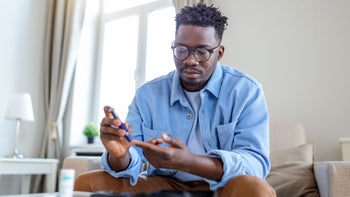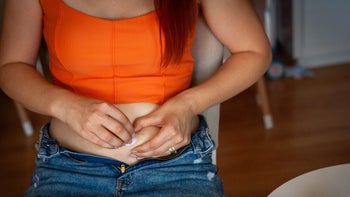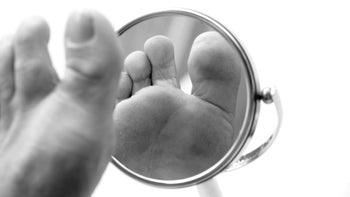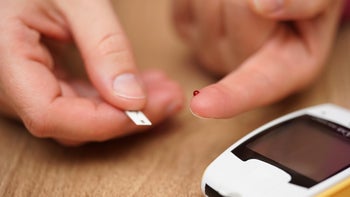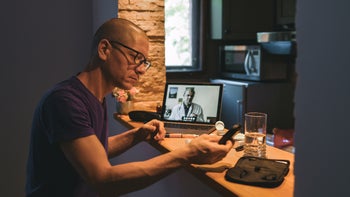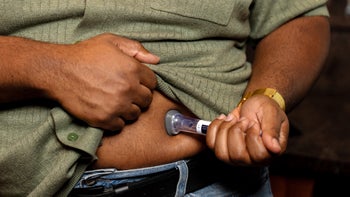
Dexcom vs. FreeStyle Libre: How Do These Continuous Glucose Monitors Compare?
Key takeaways:
Continuous glucose monitors (CGMs) are gaining a lot of attention as a tool to help people with diabetes track their blood glucose (sugar) without multiple fingersticks a day.
The Dexcom and FreeStyle Libre systems are two popular brands of CGM devices. Dexcom’s most recent models include the G6 and G7. FreeStyle currently offers three CGM models: Libre 14 Day, Libre 2, and Libre 3.
Dexcom and FreeStyle Libre have many similarities. But they differ in how their sensors, transmitters, and receivers work. They also offer different options for insulin pump connectivity.
There are ways to save on Dexcom G6 and G7. GoodRx can help you access Dexcom G6 or G7 sensors with an exclusive discount of $220 off the retail price of 3 sensors. This discount also provides $220 off each Dexcom G6 transmitter and $240 off each Dexcom G7 receiver. Patient assistance programs are also available.
Access savings on related medications
Table of contents
People living with Type 1 diabetes, and many with Type 2 diabetes, monitor their glucose (sugar) levels at home. This can be done with two devices: a blood glucose monitor (glucometer) or a continuous glucose monitor (CGM).
While both devices tell you what your glucose level is, CGM devices can help to make managing diabetes easier. CGMs offer a broader picture, improved safety, and compatibility. For these reasons, and others, CGMs have become mainstream in diabetes care. As of 2021, about 48% of people with Type 1 diabetes are using CGMs as their primary way of monitoring glucose levels.
If you’re interested in using a CGM, you might have questions about how they work and how to choose between two of the most well-known brands — Dexcom and FreeStyle Libre. Let’s discuss.
What is a continuous glucose monitor (CGM)?
CGMs are wearable devices that track changes in glucose 24 hours a day. They take glucose monitoring a step further than using a glucometer. With real-time continuous results, CGMs provide hundreds of results every day. This can help you to predict and detect lows and highs, and track glucose trends over time.
It’s important to know what your glucose is, especially if you take insulin. These results will help you to make safe decisions about medication, foods, and exercise. You can share CGM data with your diabetes care team at any time — even between appointments. This will give them the information they need to adjust your diabetes treatment plan.
Many CGMs are available, including:
Save on popular GLP-1 Agonists
Take control of your health. With GoodRx, you may be eligible to save even more on popular treatments.

They all work differently but have similar functions.
How do continuous glucose monitors work?
CGMs work by regularly tracking your glucose levels. Each monitor comes with a wearable sensor. The sensor uses a painless microneedle under the skin to detect glucose levels. Where you insert the sensor and how long you can wear it may be different for each device. Unlike a glucometer, a CGM doesn’t tell you what your blood glucose is. Instead, it monitors the amount of glucose in the fluid just beneath the skin.
Getting your results
Readings from the sensor are sent wirelessly to a receiver that displays your glucose levels. The receiver may be a small touchscreen reader, an app on your smartphone, or a compatible insulin pump. You can choose how you would like to view your glucose data. CGM trending (arrows and graphs) can be very helpful with decision making.
What happens if my blood sugar is out of range?
Some CGMs can alert you if your glucose is too high or too low. It’s important to know that not all devices have this alert system. If this function is available, your reader, phone, or insulin pump will alert you. The alert may be a noise (like a beep) or a vibration. CGMs offer an extra layer of safety by letting you know if you’re out of target range or if your glucose is getting low or high.
A CGM can be used along with, or instead of, a glucometer. But it’s important to know that a CGM can have a “lag time.” This means that it can take a bit of time for the glucose level in your tissues to catch up with the glucose levels in your blood. So even if your CGM isn’t alerting you of changes, always double-check your blood glucose with a glucometer if you’re having symptoms of high or low blood glucose.

What are the differences between Dexcom and FreeStyle Libre?
Dexcom and Abbott are the manufacturers of two very well-known CGM devices. Dexcom makes the G6 and G7 models. Abbott makes the FreeStyle Libre 14 Day, FreeStyle Libre 2, and FreeStyle Libre 3 systems.
You don’t need to calibrate (reset) any of these CGMs before using them. Each model has water-resistant sensors and transmitters, meaning you can swim and shower while wearing them. All five also allow you to view your data with a helpful graph on the reader, so you can see glucose trends throughout the day.
But all CGM devices differ based on how glucose readings are sent to the receiver, if they provide alerts for high or low sugar levels, and how often they need to be replaced. Let’s review five notable differences between devices.
1. Who can use it
The Dexcom G6 and G7 are currently FDA cleared for adults and children as young as 2 years old. FreeStyle Libre 2 and Libre 3 are available for adults and children over 4 years old. The Libre 14 Day system is only for adults 18 years and older.
2. Length of use
After inserting a sensor, CGMs have a “warm-up” period before they start working. While this time varies between CGMs, it can take between 30 minutes to 2 hours. You’ll have to use a glucometer to check your glucose during the warm-up period.
The Dexcom G6 takes 2 hours to start tracking your glucose. The G7 model takes 30 minutes — the shortest warm-up period of all CGMs. The FreeStyle Libre 14 Day, Libre 2, and Libre 3 systems take 1 hour.
Once the sensor is inserted, Dexcom G6 and G7 sensors can last for up to 10 days, and most FreeStyle Libre sensors up to 14 days. FreeStyle Libre 2 Plus is an updated version of the Libre 2 sensor. It can last for up to 15 days. It’s expected that there will be a similar change to the Libre 3 sensors to extend its wear time in the near future.
3. Frequency of readings
Dexcom G6 and G7 are what’s known as real-time CGMs. This means they automatically update your reader, smartphone app, or compatible insulin pump with new glucose levels. These devices send results to the receiver, app, or insulin pump every 5 minutes.
FreeStyle Libre 3 is also a real-time CGM device. It sends readings to your smartphone app every minute.
FreeStyle Libre 2 takes a reading every minute, and FreeStyle Libre 14 Day tracks your glucose every 15 minutes. However, these systems are known as flash glucose monitors. This means the device is monitoring your sugar at all times. The difference is that it only transmits glucose levels to the reader when you scan the sensor.
4. Low blood sugar alerts
The Dexcom G7 has customizable alerts for out-of-range glucose levels. You can choose to set alarms to vibrate or temporarily silence them. It's important to look at your receiver during this time instead. You will not receive low and high alerts (vibrations or beeping) during this time. But if you have an urgent low result, an alert will sound if you don’t respond to the vibration.
Dexcom G6 and FreeStyle Libre 3 have optional alerts for out-of-range glucose readings. But they also have special alarms for dangerously low glucose levels that you can’t turn off.
FreeStyle Libre 2 has alerts for out-of-range results. But alerts, including those for very low glucose, are optional and can be silenced if you’d prefer.
Whereas other CGMs have alerting capabilities, the FreeStyle 14 Day system does not. This is a big concern because low glucose levels (hypoglycemia) can be life-threatening. This is especially true if you have a hard time telling if your glucose is low (hypoglycemia unawareness).
5. Insulin pump compatibility
Automated insulin delivery (AID) systems are a type of insulin pump that can help make using insulin easier. AID systems automatically adjust insulin doses in response to CGM readings. This can make it easier to stay within your target glucose range by taking some of the guesswork out of diabetes management. Keep in mind that not all insulin pumps are AID systems.
Many CGMs work together with AID systems to help make adjustments to your dose. But every CGM varies when it comes to insulin pump compatibility:
Dexcom G7: Compatible with iLet Bionic Pancreas and Tandem t:slim X2
Dexcom G6: Compatible with Omnipod 5, iLet Bionic Pancreas, and Tandem t:slim X2
FreeStyle Libre 3: Insulin pump compatibility in the U.S. expected in the near future
FreeStyle Libre 2: Compatible with Tandem t:slim X2
FreeStyle Libre 14 Day: Not cleared for insulin pump connectivity
Dexcom vs. Freestyle Libre cost
Depending on which brand you’re purchasing, you may have two or three separate items to pay for. Moreover, all CGM systems require a prescription in order to buy them.
Dexcom’s G7’s average cost without insurance is about $470 for 3 sensors (a typical 30-day supply). Sensors are designed to last for up to 10 days each. This is the only prescription you will need for this CGM. The G7 is an all-in-one fully disposable system. So there’s no need to order transmitters with the G7.
Dexcom G6’s average cost without insurance is about $450 for the receiver, $300 for 1 transmitter, and $440 for 3 sensors. You’d need a separate prescription for each item. A transmitter has a 90-day battery life, but the Dexcom G6 sensors need to be replaced every 10 days. Receivers are meant to last for years, and insurance providers restrict how often you can get a new one.
The FreeStyle Libre 14 Day and Libre 2 readers cost about $87 without insurance. The FreeStyle 14 Day system sensors cost about $77 for a 28-day supply. The same amount of sensors for the Libre 2 system cost around $160. Again, you’ll need separate prescriptions for the reader and sensors. FreeStyle Libre 3 sensors cost about $150 for a 28-day supply.
Are both Dexcom and FreeStyle Libre covered by insurance?
While this depends on your personal insurance plan, many insurances — including Medicare — now cover CGMs for people with diabetes similar to how they cover glucometers. It’s possible your plan may only cover one brand, so it’s best to contact your insurance to ask for details.
If you don’t have diabetes and are interested in using a CGM, it’s unlikely your insurance will cover these devices. This may also be the case if you have prediabetes or gestational diabetes (diabetes during pregnancy). But there are still some ways to save and avoid paying the full retail price.
How to save on a continuous glucose monitor
There are ways to save on diabetes testing supplies, including CGM devices. GoodRx can help you navigate the ways to save on your Dexcom or FreeStyle Libre prescription.
How to save on Dexcom
There are ways to save on Dexcom G6 and G7. GoodRx can help you navigate between GoodRx coupons and patient assistance programs to save money on your prescription.
Save with GoodRx. Anyone with a valid prescription, regardless of insurance status, can use GoodRx to purchase a 30-day supply of Dexcom G6 or G7 sensors with an exclusive discount of $220 off the retail price. This discount also provides $220 off each Dexcom G6 transmitter and $240 off each Dexcom G7 receiver.
Save with a patient assistance program. If you’re uninsured or underinsured, you may be eligible for Dexcom’s patient assistance program, which may offer the device for free or at a reduced cost.
How to save on FreeStyle Libre
Here are some ways to save on FreeStyle Libre:
Save with GoodRx. GoodRx can help you save over 30% off the average retail price of the sensors. FreeStyle Libre 3’s price at certain pharmacies is as low as $135.99 with a free GoodRx discount. FreeStyle Libre 2’s price at certain pharmacies is as low as $148.49 with a free GoodRx discount.
Save with a free trial. Abbott offers a free 14-day trial of the Libre 2 and Libre 3 with the MyFreeStyle program. If you qualify, you’ll receive a voucher for one free sensor. You can present the voucher at your preferred pharmacy.
Who is a continuous glucose monitor good for?
A CGM can be helpful for anyone living with diabetes. But it's even more beneficial for those missing early warning signs of low glucose. There’s also growing interest in whether CGMs can be good for people without diabetes, but this is less clear.
People with diabetes
If you have diabetes, a CGM can help you better manage your glucose over time and monitor for trends. You will notice what activities and foods are associated with your highs and lows. Other benefits of CGMs include:
Helping people with diabetes meet their hemoglobin A1C (HbA1C or A1C) target goals
Having the ability to measure your time in range (TIR) — meaning the percent of time your glucose is within your target range
Potentially lowering the risk of low glucose (hypoglycemia)
Potentially lowering the risk of diabetic ketoacidosis (DKA) — a life-threatening complication that can happen when glucose levels are very high
People without diabetes
People without diabetes have started using CGMs to monitor their glucose levels for personal reasons, including:
To guide diet or exercise plans
To track fitness patterns
To build athletic endurance
To maintain higher athletic performance levels
Currently, there’s no evidence about whether using CGMs for people without diabetes has any long-term health benefits. But an ongoing clinical trial is researching one possible benefit. This study will look at whether people without diabetes can lose weight more effectively by using CGM devices.
The bottom line
Dexcom G6 and FreeStyle Libre continuous glucose monitors (CGMs) offer new ways to monitor your glucose (sugar) without having to prick your fingers multiple times a day. They can help people better manage diabetes than traditional glucose meters. CGMs might also reduce the risk of low glucose. The Dexcom and FreeStyle Libre CGMs differ in how glucose information is shared, what devices are compatible, and how long a sensor lasts. Talk to your diabetes care team about which CGM might be for you.
Why trust our experts?



Abbott. (n.d.). FreeStyle Libre 14 day system in service guide.
Abbott. (n.d.). Get started your guide to the FreeStyle Libre 2 system.
Abbott. (2018). FreeStyle Libre 14 day flash glucose monitoring system.
Abbott. (2020). FreeStyle Libre 2: Now available in the U.S.. Diabetes Care.
Abbott. (2023). FreeStyle Libre 3.
Abbott. (2023). U.S. FDA clears Abbott's Freestyle Libre 2 and Freestyle Libre 3 sensors for integration with automated insulin delivery systems.
American Diabetes Association. (n.d.). CGM & time in range.
American Diabetes Association. (n.d.). Choosing a CGM.
Beta Bionics. (2023). Beta Bionics announces the nationwide launch of the iLet Bionic Pancreas with Dexcom G7 CGM system.
Clinicaltrials.gov. (2023). Use of continuous glucose monitoring in non-diabetic population to compliment Signos mobile health platform. Signos Inc.
Desalvo, D. J., et al. (2023). Patient demographics and clinical outcomes among Type 1 diabetes patients using continuous glucose monitors: Data from T1D exchange real-world observational study. Journal of Diabetes Science and Technology.
Dexcom. (n.d.). Dexcom G6 system user guide.
Dexcom. (n.d.). Dexcom G7 system user guide.
Dexcom. (n.d.). Using the Dexcom G7 app.
Dexcom. (2023). Dexcom G6 strengthens its position as world’s most connected CGM system.
Edelman, S. V., et al. (2018). Clinical implications of real-time and intermittently scanned continuous glucose monitoring. Diabetes Care.
Endocrine Society. (n.d.). Continuous glucose monitoring.
Laffel, L. M., et al. (2020). Effect of continuous glucose monitoring on glycemic control in adolescents and young adults with type 1 diabetes a randomized clinical trial. JAMA.
Reddy, M., et al. (2018). A randomized controlled pilot study of continuous glucose monitoring and flash glucose monitoring in people with Type 1 diabetes and impaired awareness of hypoglycaemia. Diabetic Medicine.
Sharifi, Y., et al. (2022). Hypoglycemic unawareness: Challenges, triggers, and recommendations in patients with hypoglycemic unawareness: A case report. Journal of Medical Case Reports.
Sifferlin, A. (2017). Why perfectly healthy people are using diabetes monitors. Time.
Tandem Diabetes Care. (2023). Tandem Diabetes Care launches t:slim X2 insulin pump software with Dexcom G7 CGM integration in U.S.
Tandem Diabetes Care. (2024). Tandem Diabetes Care’s t:slim X2™ insulin pump is the first automated insulin delivery system to integrate with Abbott’s new FreeStyle Libre 2 Plus sensor.
Wolpert, H. A. (2007). Use of continuous glucose monitoring in the detection and prevention of hypoglycemia. Journal of Diabetes Science and Technology.










